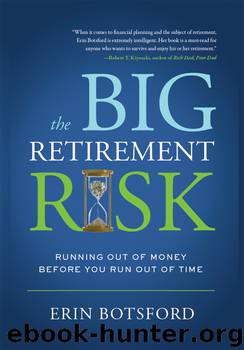The Big Retirement Risk by Erin Botsford

Author:Erin Botsford [Botsford, Erin]
Language: eng
Format: epub
ISBN: 978-1-60832-249-7
Publisher: Greenleaf Book Group
Published: 2012-04-05T04:00:00+00:00
CORPORATE BONDS
Corporate bonds are the most straightforward type of bond and subsequently the easiest to understand. Very basically, they are IOUs issued by a major corporation. The credit rating of the corporation is an important factor to consider when investing in corporate bonds. Just ask investors who owned General Motors or Lehman Brothers bonds in 2008. What’s the lesson to be learned? Though many people associate bonds with safety, this is clearly not always the case.
One strategy is to “ladder” your corporate bond portfolio. To create this setup, you purchase bonds with varying terms and maturity dates—say, five years, ten years, and fifteen years. As the bonds mature, you reinvest the proceeds in the longest-term bond of your ladder—fifteen-year bonds in our example. This allows investors to receive ongoing interest payments, and every five years they will receive the principal to then deploy back into the strategy. By holding the bonds until maturity, interest-rate risk is not an issue.
One of our clients, whom I will call “Chuck,” had approximately $3 million to invest, all of it in an IRA. What he chose to do was to select investment-grade bonds (bonds with a rating of BBB or better) in increments of $15,000. Chuck’s average yield on the portfolio was roughly 5 percent, so he could effectively count on about $150,000/year in income from his portfolio.
Chuck knew his biggest risk was that if interest rates went higher, the value of his bonds could go lower, but he was willing to accept that. He did not intend to sell any of the bonds prior to maturity, and the average of the bonds matured in eight to ten years. He figured he would have the cash again sometime in the future to redeploy the money into higher-yielding bonds if that was where interest rates were at the time. Chuck was also well aware of the risk of default by the underlying corporations. But he felt that having small positions, each representing a fractional percentage of his overall portfolio, mitigated this risk.
This was not the only money Chuck had, but this strategy effectively provided for his monthly income, along with his Social Security and some royalties from an oil well owned by his wife. Because his income was defined and relatively predictable, he was then able to be more aggressive with his Non-Lifestyle dollars. He did not favor putting many, if any, of his investment dollars in the stock market, but instead chose to invest his Non-Lifestyle dollars in private equity offerings. Today Chuck and his wife have a very comfortable lifestyle, and his strategy has worked out very happily for everyone involved.
Download
This site does not store any files on its server. We only index and link to content provided by other sites. Please contact the content providers to delete copyright contents if any and email us, we'll remove relevant links or contents immediately.
The Compound Effect by Darren Hardy(8523)
Tools of Titans by Timothy Ferriss(7824)
Nudge - Improving Decisions about Health, Wealth, and Happiness by Thaler Sunstein(7255)
Win Bigly by Scott Adams(6831)
Deep Work by Cal Newport(6574)
Rich Dad Poor Dad by Robert T. Kiyosaki(6185)
Pioneering Portfolio Management by David F. Swensen(6083)
Principles: Life and Work by Ray Dalio(5981)
The Barefoot Investor by Scott Pape(5596)
Digital Minimalism by Cal Newport;(5396)
Grit by Angela Duckworth(5302)
The Slight Edge by Jeff Olson(5202)
Discipline Equals Freedom by Jocko Willink(5159)
The Motivation Myth by Jeff Haden(5009)
You Are a Badass at Making Money by Jen Sincero(4658)
The Four Tendencies by Gretchen Rubin(4427)
Eat That Frog! by Brian Tracy(4165)
The Confidence Code by Katty Kay(4041)
Bullshit Jobs by David Graeber(3837)
